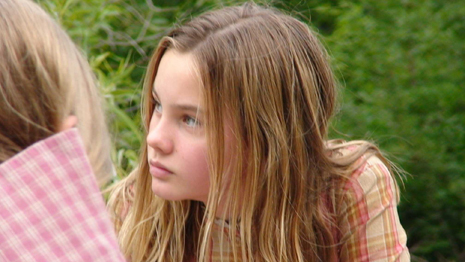« Pan’s Labyrinth (2006) – Movie Review | Home | The Lives of Others (2006) – Movie Review »
The Last Sin Eater (2007) – Movie Review
By Robert L. Jones | February 9, 2007

Liana Liberato stars as Cadi Forbes in "The Last Sin Eater"
The Importance of Being Earnest
[xrr rating=3/5]
The Last Sin Eater. Starring Louise Fletcher, Henry Thomas, Soren Fulton, A.J. Buckley, Stewart Finlay-McLennan, Peter Wingfield, Elizabeth Lackey, Thea Rose, Gabrielle Fitzpatrick, and introducing Liana Liberato. Music by Mark McKenzie. Cinematography by Robert Seaman. Screenplay by Brian Bird and Michael Landon, Jr., based on the novel by Francine Rivers. Edited and directed by Michael Landon, Jr. (FoxFaith, 2007, Color, 141 minutes. MPAA Rating: PG-13).
Another costume drama, The Last Sin Eater tells a tale of redemption strikingly similar to Pan’s Labyrinth through its heroine, another girl on the cusp of adolescence and responsibility of adulthood. They also share a similar plot structure (the ordeal) and even the same stock characters. However, the two are worlds apart.
The fledgling FoxFaith line of inspirational Christian movies released this picture. To me, it’s kind of “made for TV” filmmaking that’s like the proverbial fingernails dragged down the chalkboard: Awkward, dramatically inconsistent performances (especially among the children actors); uneven pacing and slack editing; generic-looking costumes and sets; inter-cutting of 35mm location shots with what appears to be 16mm stock footage; and, a director who uses embarrassingly primitive special effects like “Chroma-Key” bluescreen process, which Alfred Hitchcock deemed obsolete as long ago as 1962, when he made his terror classic The Birds. Dismissed by most reviewers, don’t hold your breath waiting for the Academy of Motion Pictures Arts and Sciences to bestow its cherished imprimatur upon this “nice try” by a director whom the producers should have barred from the editing room.
And, although you might think I’m gearing up to “pan” another film (pun intended), think twice. Why? Because, since I was a kid, I don’t watch movies simply to revel in their technical merits. I go because I want to be entertained, perhaps even enlightened, by a great story.
The technically virtuosic Pan’s Labyrinth left me cold because it was all style and no substance. Yet, despite its glaring aesthetic deficits, I loved this one precisely because it had the crucial ingredient the former lacked: A great story. More so than its message, a movie’s story is its soul.
The Last Sin Eater takes place in a Welsh settlement in 1850s Appalachia. Ten year-old Cadi Forbes (Liana Liberato) hides a dark secret that weighs heavy on her conscience. She tries hard to repress it, but an incident at her grandmother’s funeral reopens the barely-healed wound.
At her burial, something’s horribly amiss: The ceremony, bereft of comforting eulogy, seems more of a witch’s sabbath than a passing onto the next life. Held under the cover of darkness, Cadi’s granny lies in state before the silent mourners, a piece of bread and a bladder full of wine lying on her chest.
Cutting through the eerie stillness, a hooded figure appears, the Sin Eater (Peter Wingfield). He scarfs down the bread and gulps the wine, and in a sorrowful voice—having cleansed the old woman’s sins by condemning his own soul—recites a solemn wish for her forgiveness. No one looks at or speaks to the Sin Eater (it’s rumored that the very act of communicating with the wretched outcast brings eternal damnation) but while everyone’s heads are gravely bowed, Cadi hears something painful yet oddly benign in his voice. She doesn’t fear looking into his eyes, because she already feels doomed by her transgression.
Cadi’s identification with the Sin Eater soon becomes an obsession: Unable to live with herself, a couple days later she seeks him out. She goes into the mountains to find him, despite others’ warnings.
Here is real heroism: Cadi’s refusal to heed superstitious gossip and deny the evidence of her own experience buttresses her resolve to forge on in her quest. We soon learn her secret—her sister’s accidental death, by falling off a tree bridge over a waterfall—was prompted, partly, by Cadi’s stubbornness. However, her very intransigence is also the key to her eventual redemption.
Around this point, the plot comes to a standstill as it meanders. Unable to take the clumsy dialogue of the three child actors, I get ready to exit the theater. Only one thing keeps me pinned in my seat: What will happen next?
Cadi eventually tracks down the Sin Eater to his secret cave, he reluctantly performs the sin eating rite, never having done it for a living person. She feels nothing, and descends the mountain just as encumbered as she was going up.
On her way home, she happens upon a Man of God (Henry Thomas) alone and preaching the gospel to no one in particular along the river. Seeing that she’s troubled, he gets her to open up about her predicament. He laughs, and divulges to Cadi that the mortal Sin Eater cannot relieve her guilt, that long ago there was a true sin eater named Jesus Christ, whose grace has made it possible for her to be forgiven for her sins while still alive, rather than having to wear them like an albatross around her neck until death.
Suddenly, Cadi feels the weight of the world lifted from her shoulders. She runs to tell everyone. “Know the truth, and the truth shall set you free.”
But now the mystery has just begun. Why is the immigrant enclave ignorant of this common knowledge of Christ’s salvation? Why must a doomed man endure ostracism, serving a miserable sentence performing atavistic pagan rituals? And why does village bully Brogan Kai (Stewart Finlay-McLennan, whose thuggish performance recalls Ward Bond and George Kennedy) corner the Man of God, killing this “outsider,” lest his words reach the village?
As Cadi hides from Brogan, she returns to the mountain, where we find out the settlers’ real sin, a secret that’s haunted two generations. Cadi tells the Sin Eater the good news, but he’s unable to accept the tragic fate of having been denied the love of the woman he loved, fathering children and a purposeful, fulfilling life for naught. His agony resonates deeply as he begs her off. “It means I will have wasted twenty years of my life in this cave and never saved a single soul from damnation,” he cries, breaking down.
Being an old-fashioned movie, Louise Fletcher (best known for her Oscar-winning role of sadistic Nurse Ratched in 1975’s One Flew Over the Cuckoo’s Nest) as village elder Miz Elda is the movie’s Deux ex machina, who calls a town meeting that night to divulge the secret. Her testimony opens up a lot of old wounds, but, rather than burning the village to the ground a la avenging angel Clint Eastwood in his 1973 revenge fantasy High Plains Drifter, Elda’s words instead lift the shadows of superstition and scapegoating that kept them in darkness.
The Sin Eater renounces his dark avocation, becomes a preacher and saves souls instead in the sunlight by the river. The movie closes with Cadi exclaiming its moral, that she’s been set free because Christ died for her sins. Not very subtle, but consider the context and target audience.
But, that audience already knows that bit of information. The moral was a rather ingenious MacGuffin for a life-affirming message that sin is an aberration, not man’s constant state and a this-worldly metaphysics that individuals have the inherent right and dignity to live as men, not objects of sacrifice. In other words, “Jesus died for our sins, so now we can all get on with the business of living.”
Maybe it’s not just the sex, moral decadence and profanity driving the faithful to these new religious pictures. From the looks of this one, maybe it’s not only preaching to the choir, either. Perhaps, just like everyone else staying away in droves from movie theaters nowadays, they too just want to see motion pictures that tell fascinating stories, project a benevolent sense of life and present man as clean, heroic, and productive.
And maybe, just maybe, they’re getting fed-up with being patronized as unsophisticated rubes for wanting everybody to live—horror of horrors—happily ever after.
Robert L. Jones is a photojournalist living and working in Minnesota. His work has appeared in Black & White Magazine, Entrepreneur, Hoy! New York, the New York Post, RCA Victor (Japan), Scene in San Antonio, Spirit Magazine (Canada), Top Producer, and the Trenton Times. Mr. Jones is a past entertainment editor of The New Individualist.
Topics: Christian Movies, Costume Dramas, Dramas, Movie Reviews, Religious Dramas | Comments Off on The Last Sin Eater (2007) – Movie Review
